Dumbarton Castle
| Dumbarton Castle | |
|
Dunbartonshire | |
|---|---|
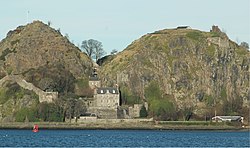 Dumbarton Castle from across the Clyde | |
| Location | |
| Grid reference: | NS399744 |
| Location: | 55°56’10"N, 4°33’46"W |
| Town: | Dumbarton |
| History | |
| Information | |
Dumbarton Castle has the longest recorded history of any stronghold in Scotland. It overlooks the town of Dumbarton, county town of Dunbartonshire, standing on a 240-foot high plug of volcanic basalt known as Dumbarton Rock.
History
Iron Age
At least as far back as the Iron Age, this has been the site of a strategically important settlement. Its early residents were known to have traded with the Romans. The presence of a settlement is first recorded in a letter St Patrick wrote to King Ceretic of Alt Clut in the late 5th century.
Dark Ages
Dumbarton might have been the Cair Brithon ("Fort of the Britons") listed by Nennius among the 28 cities of Sub-Roman Britain.[1] From the fifth century until the ninth, the castle was the centre of the Kingdom of Strathclyde. Alt Clut or Alcluith (Gaelic: Alt Chluaidh, (literally 'Rock of the Clyde'), the Old Welsh name for Dumbarton Rock, became a metonym for kingdom. The king of Dumbarton in about AD 570 was Riderch Hael, who features in Welsh and Latin works.
The Gaels, enemies of Strathclyde, named the city Dùn Breatainn – 'Fort of the Britons' – from which comes the name of Dumbarton.
In 756, the first (and second) losses of Dumbarton Rock were recorded. A joint force of Picts and Northumbrians captured Alcluith after a siege, only to lose it again a few days later. By 870, Dumbarton Rock was home to a tightly packed British settlement, which served as a fortress and as the capital of Alt Clut. The Vikings laid siege to Dumbarton for four months, eventually defeating the inhabitants when they cut off their water supply. The Norse king Olaf returned to his kingdom in Dublin in 871, with two hundred ships full of slaves and looted treasures. Olaf came to an agreement with Constantine I of Scotland, and Artgal of Alt Clut.
Strathclyde's independence may have come to an end with the death of Owen the Bald, when the dynasty of Kenneth mac Alpin began to rule the region.
Mediæval Era
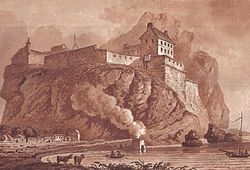
In mediæval Scotland, Dumbarton was an important royal castle. It sheltered David II and his young wife, Joan of The Tower after the Scottish defeat Halidon Hill in 1333.
In 1425 the castle was attacked by James the Fat, youngest son of Murdoch Stewart, Duke of Albany, who had been imprisoned by King James I of Scotland on charges of treason. James the Fat became a rallying point for enemies of the King, and raised a large rebellion against the crown. He marched on the town of Dumbarton and burned it, but was unable to take the castle, whose defender John Colquhoun successfully held out against James' men. [2] [3]
Patrick Hepburn, 1st Earl of Bothwell, was Captain of Dumbarton castle on 1 April 1495.
Sixteenth century
During the war of the Rough Wooing, the castle was briefly occupied against the Scottish Government of Regent Arran by the Bishop of Caithness, Robert Stewart, a brother of Matthew Stewart, 4th Earl of Lennox, who came from England with the support of Henry VIII. He had sailed from Chester with around 20 followers in May 1546 in the Katherine Goodman and a pinnace.[4] Having borrowed the artillery of the Earl of Argyle, Arran successfully besieged the castle, which surrendered after 20 days. The chronicle historian John Lesley wrote that the Captain and the Bishop surrendered the castle to Arran and were rewarded, after negotiation by the Earl of Huntly.[5] The siege at Dumbarton delayed Arran's action at the siege of St Andrews Castle on the east coast of Scotland.[6]
In 1548, after the Battle of Pinkie Cleugh, east of Edinburgh, the infant Mary, Queen of Scots was kept at the castle for several months before her removal to France for safety, where she was soon betrothed to the young Dauphin, Francis.
In October 1570 during the Marian civil war, John Fleming, 5th Lord Fleming fortified the castle for Mary against the supporters of the infant King James VI with stones he obtained by demolishing churches and houses in Dumbarton and Cardross.[7] His defence of Dumbarton for Mary was satirized in a ballad printed by Robert Lekprevik in May 1570; The tressoun of Dumbertane.[8] Attributed to Robert Sempill, the ballad describes Fleming's failed ambush of Sir William Drury.[9] The castle was captured by the forces of the Regent (Matthew Stewart, 4th Earl of Lennox) led by Thomas Crawford of Jordanhill and John Cunningham of Drumquhassle in the early hours of 2 April 1571, who used ladders to scale the rock and surprise the garrison.[10]
Seventeenth century
The castle's importance declined after Oliver Cromwell's death in 1658. Due to threats posed by Jacobites and the French in the eighteenth century, new structures and defences were built there and the army continued to garrison the castle until Second World War.
Legends
Legend brings Dumbarton into the Arthurian legends. The wizard Merlin was said to have stayed at Alt Clut. The mediæval Scalacronica of Sir Thomas Grey records the legend that King Arthur left Hoël of Little Britain (Brittany) his nephew sick at Alcluit in Scotland."[11] Hoël made a full recovery, but was besieged in the castle by the Scots and Picts. The story first appeared in Geoffrey of Monmouth's Historia Regum Britanniae.[12]
Amongst lists of three things, in the triads of the Red Book of Hergest, the third "Unrestrained Ravaging" was Aeddan Fradog (the Wily, perhaps Áedán mac Gabráin), coming to the court of Rhydderch the Generous at Alclud, who left neither food nor drink nor beast alive. This battle also appears in stories of Myrddin Wyllt, the Merlin of Geoffrey of Monmouth's Vita Merlini, perhaps conflated with the battle of Arfderydd, located as Arthuret by some authors.[13]
The castle today
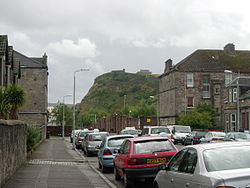
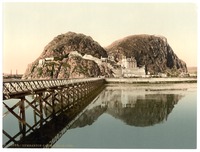
Today all visible traces of the Dark-Age Alt Clut, its buildings and defences, have gone. Not much survives from the mediæval castle: the 14th-century Portcullis Arch, the foundations of the Wallace Tower, and what may be the foundations of the White Tower. There is a 16th-century guard house, which includes a face which according to legend is "Fause Menteith", who betrayed William Wallace.
Most of the existing structures were built in the 18th century, including the Governor's House, built for John Kennedy, 8th Earl of Cassilis, and fortifications which demonstrated the struggle by military engineers to adapt an intractable site to contemporary defensive needs. The splendid views from the twin summits of the White Tower Crag and the Beak remind us why this rocky outcrop was chosen as 'the fortress of the Britons' centuries ago. [14]
The castle is open on a daily basis during the summer season and Saturday-Wednesday in the winter. Visitors must climb the 557 steps to see the White Tower Crag and other features.
The whole of Dumbarton Rock is in state ownership and is legally protected as a Scheduled Ancient Monument.
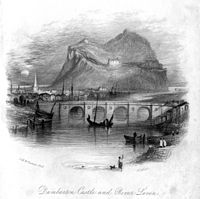
Outside links
- 100
- Clyde Waterfront Heritage, Dumbarton Castle
- www.rampantscotland.com Dumbarton Castle
- Electric Scotland on the castle
- Map of Geoffrey of Monmouth's Britain, including Dumbarton, Siân Echard, University of British Columbia
- Engraving of Dumbarton Castle from the West in 1693 by John Slezer at National Library of Scotland
References
- ↑ Ford, David Nash. "[www.britannia.com/history/ebk/articles/nenniuscities.html The 28 Cities of Britain]" at Britannia. 2000.
- ↑ McAndrew, Bruce A., p.5, Scotland's Historic Heraldry Retrieved November 2010
- ↑ Campbell, Alastair, p. 113, A History of Clan Campbell, Volume 2 Retrieved November 2010
- ↑ Dasent, ed., Acts of the Privy Council, 1542-1547, vol.1 (1890), 379
- ↑ Thomson, Thomas, ed., John Lesley's History of Scotland, Bannatyne Club (1830), 190.
- ↑ Accounts of the Lord High Treasurer of Scotland, vol. 8 (1908), lxxx, 453, 465: Letters & Papers Henry VIII, vol.21 part 2 (1910) no.6, Arran to the Pope.
- ↑ Calendar State Papers Scotland, vol. 3, (1903), 383.
- ↑ Calendar of State Papers Scotland, vol. 3, (1903), 177: The tressoun of Dumbarton, 15 May, Robert Lekprevik, Edinburgh, 1570.
- ↑ Cranstoun, James, Satirical Poems of the Reformation, vol. 1 (1892) 170-173, & notes vol. 2 (1893), 113-7.
- ↑ Lang, Andrew (1911). A History of Scotland. W. Blackwood in Edinburgh. pp. 64–68. http://www.archive.org/stream/shorthistoryofsc02languoft#page/64/mode/2up.
- ↑ Leland, John, Collectanea, vol.1 part 2 (1770), p.510. John Leland's note of the Scalachronica: Sir Thomas Grey of Heton, Scalachronica, Edinburgh, (1836), p.318, French: "et lessa Hoel son neuew de la Peteit Bretaigne a Alclud en Escoz maladez."
- ↑ Schultz Albert, ed., Historia Regum Britanniae (1854), pp.125-6
- ↑ Ritson, J., Annals of the Caledonians, Picts, and Scots; and of Strathclyde, Cumberland, Galloway and Murray, (1828), pp.164-5, quoting Humphrey Llwyd
- ↑ "Historic Scotland Official Souvenir Guide"